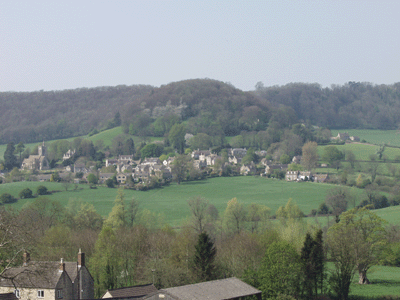
|
| West Hill at Uley seen from the south-east. The temple stood just to the right of the spur. Below the hilltop is the modern village. (photo: John Pearce) |
Geophysical survey and observation of Roman building materials and artefacts in surrounding fields show that settlement around the sanctuary extended well beyond the excavated area. The temple and other excavated buildings stood in a hamlet or small village, covering perhaps six hectares. This settlement is likely to have served the needs of visitors or pilgrims to the shrine, providing shelter, producing or selling votives, including curse tablets. Perhaps too it hosted periodic fairs and markets associated with festivals celebrated at the temple. The structures also probably housed the permanent residents at the settlement on West Hill, accommodating the agricultural and craft activities typical of Romano-British rural settlements. Much of the material found at Uley represents the residue of everyday life.
West Hill, on which this settlement stood, is a spur projecting from the western edge of the Cotswold scarp, above the modern village of Uley to the south and overlooking the Severn valley to the west. The inhabitants of the settlement would have enjoyed a superb view from the Cotswold scarp across the Severn and the Forest of Dean. The temple itself was better placed for a view across the valley of the Ewelme to the south-east. Viewed from this valley the temple is likely to have been a prominent feature on the spur.
The nearest towns to Uley were the colony of Glevum (Gloucester), 19km to the north, and Corinium (Cirencester), 25km to the east, the civitas capital of the Dobunni. To the south-east the Fosse Way connected Bath and Cirencester, while the road running south-west from Gloucester passed along the Severn valley below West Hill. The temple perhaps served the inhabitants of the local rural landscape, thickly settled in the Roman period by farms and villas. Amongst the latter is one of the most spectacular of all Roman villas from Britain, the 'palatial' complex at Woodchester.
previous: introduction next: history